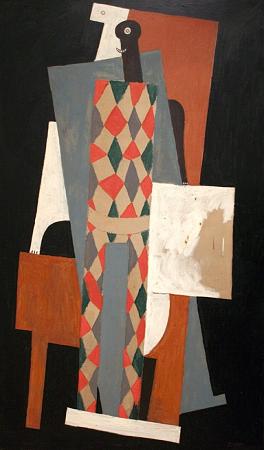Harlequin. Harlequin is the best-known of the zanni or comic servant characters from the Italian Commedia dell'arte. The role is traditionally believed to have been introduced by Zan Ganassa in the late 16th century, was definitively popularized by the Italian actor Tristano Martinelli in Paris in 1584-1585, and became a stock character after Martinelli's death in 1630. The Harlequin is characterized by his chequered costume. His role is that of a light-hearted, nimble, and astute servant, often acting to thwart the plans of his master, and pursuing his own love interest, Columbina, with wit and resourcefulness, often competing with the sterner and melancholic Pierrot. He later develops into a prototype of the romantic hero. Harlequin inherits his physical agility and his trickster qualities, as well as his name, from a mischievous devil character in medieval passion plays. The Harlequin character first appeared in England early in the 17th century and took centre stage in the derived genre of the Harlequinade, developed in the early 18th century by John Rich. As the Harlequinade portion of English dramatic genre pantomime developed, Harlequin was routinely paired with the character Clown. As developed by Joseph Grimaldi around 1800, Clown became the mischievous and brutish foil for the more sophisticated Harlequin, who became more of a romantic character. The most influential such in Victorian England were William Payne and his sons the Payne Brothers, the latter active during the 1860s and 1870s. Further information: Herla, Erlking, and Alichino Although the origins of the Harlequin are obscure, there are several theories for how the character came to be. One theory posits that the name is derived from a bird with polychromatic feathers called a Harle. Another theory suggest that the name Harlequin is taken from that of a mischievous devil or demon character in popular French passion plays. It originates with an Old French term herlequin, hellequin, first attested in the 11th century, by the chronicler Orderic Vitalis, who recounts a story of a monk who was pursued by a troop of demons when wandering on the coast of Normandy at night.These demons were led by a masked, club-wielding giant and they were known as familia herlequin. This medieval French version of the Germanic Wild Hunt, Mesnee d'Hellequin, has been connected to the English figure of Herla cyning. Hellequin was depicted as a black-faced emissary of the devil, roaming the countryside with a group of demons chasing the damned souls of evil people to Hell. The physical appearance of Hellequin offers an explanation for the traditional colours of Harlequin's red-and-black mask. The name's origin could also be traced to a knight from the 9th century, Hellequin of Boulogne, who died fighting the Normans and originated a legend of devils. Cantos XXI and XXII from Dante's Inferno there is a devil by the name of Alichino. The similarities between the devil in Dante's Inferno and the Arlecchino are more than cosmetic and that the prank like antics of the devils in the aforementioned antics reflect some carnivalesque aspects. The first known appearance on stage of Hellequin is dated to 1262, the character of a masked and hooded devil in Jeu da la Feuilliere by Adam de la Halle, and it became a stock character in French passion plays. The re-interpretation of the devil stock character as a zanni character of the commedia dell'arte took place in the 16th century in France. Zan Ganassa, whose troupe is first mentioned in Mantua in the late 1560s, is one of the earliest known actors suggested to have performed the part, although there is little hard evidence to support. Ganassa performed in France in 1571, and if he did play the part there, he left the field open for another actor to take up the role, when he took his troupe to Spain permanently in 1574. Among the earliest depictions of the character are a Flemish painting in the Museum of Bayeux and several woodblock prints probably dating from the 1580s in the Fossard collection, discovered by Agne Beijer in the 1920s among uncatalogued items in the Nationalmuseum Stockholm. Tristano Martinelli is the first actor definitely known to have used the name 'Harlequin' for the secondo zanni role, and he probably first performed the part in France in 1584 and only later brought the character to Italy, where he became known as Arlecchino. The motley costume is sometimes attributed to Martinelli, who wore a linen costume of colourful patches, and a hare-tail on his cap to indicate cowardice. Martinelli's Harlequin also had a black leather half-mask, a moustache and a pointed beard.
more...









